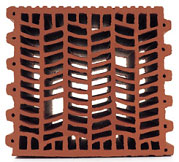
Photo from wikipedia
In this article, the development of a new low damage clay brick infill wall system has been reported. The solution enables an engineer to control the drift level after which… Click to show full abstract
In this article, the development of a new low damage clay brick infill wall system has been reported. The solution enables an engineer to control the drift level after which the infill wall damage can be allowed. This is achieved by utilizing a system of individual rocking clay brick infill panels rather than a single squat infill wall, which minimizes the interaction between the infill wall and the structural system until a selected design drift level. The solution is a workaround for the controversial aspects of clay brick infill walls, which are brittleness, or lack of deformability/ductility and unreliable strength. The seismic performances of an as-built unreinforced clay brick infill wall and the developed low damage clay brick infill wall system were evaluated by 2D quasi static tests. The results were calibrated and used for the analysis of a typical New Zealand building model in order to observe the effects of the as-built and the low damage infill wall systems on the maximum inter-story drift profiles of the structure. Past design codes consider infill walls within frame buildings as non-structural elements; thus, these walls have been typically neglected in the analysis of a building. The observations made after major earthquakes in recent years have repeatedly shown that infill walls interact with the structural system during seismic actions and modify the behavior of the structure. More recent code design provisions recognize the complexity of such interactions and require either (a) consider these effects of frame-infill interaction during the design and modeling phase or (b) assure no or low-interaction of the two systems with proper detailing and arrangements in the construction phase. To consider the interaction in the design stage can be impractical and in most cases does not solve the actual problem related to their brittle behavior. On the other hand, considering the low interaction, not much technical information/design guide is available to the engineers, which is the problem tackled in this article.
Journal Title: Journal of Earthquake Engineering
Year Published: 2017
Link to full text (if available)
Share on Social Media: Sign Up to like & get
recommendations!